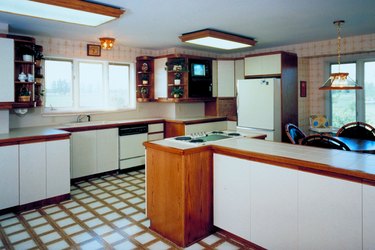
Planning a kitchen remodel requires a number of important decisions, such as whether to install the cabinetry first or the flooring. If the flooring is installed first, it may be damaged by cabinet installers. Contractors often cover the flooring with heavy paper to protect it during cabinet installation. However, paper won't protect the floors from heavy traffic or dings from dropped tools. If the cabinets go in first, the flooring can be precisely fitted for a cohesive, professional look. Either option has advantages and disadvantages.
Flooring Before Cabinets
Video of the Day
Installing the floors before the cabinets has some advantages. The flooring contractor will not have to work around existing cabinetry so the work can go that much faster. The finish can be applied after the cabinet installation, lessening concerns about marring the floors during the remodel. There will be some transition problems if the homeowner decides to change the cabinetry at a later date, however. New tiles can be added to tile flooring, but hardwood flooring that has been under cabinets will always have a different look than floors that have been walked on.
Video of the Day
Cabinets Before Flooring
Setting the cabinetry in place before installing the flooring means not having to worry about floor damage during cabinet installation. The flooring can be installed to fit snugly against the new cabinetry and appliances. Additionally, if the new cabinetry will remain in place over the long term, homeowners have the option of purchasing less flooring material since it will not have to run under the cabinetry.
Costs
If the flooring contractor has to work around existing cabinetry, the costs may be higher than expected since special cuts may be needed and extra care must be taken. Also, there may be additional costs and scheduling issues if the flooring contractor has to come back to refinish the floors after the cabinets have been installed. As a cost-saving measure, some homeowners opt to install inexpensive plywood under the cabinetry as a substitute for putting down expensive flooring that will be hidden.
Considerations
Laminate floors should be installed after the cabinetry because the material needs to be able to expand and contract depending on humidity levels. Tile or linoleum, on the other hand, can run all the way to the wall with no problems. Sometimes the decision of whether to install the cabinets or the floors first depends on other factors. Delivery schedules or availability of labor can influence the installation as well. Cost considerations, flooring materials and long-term design preferences should guide the final decision.